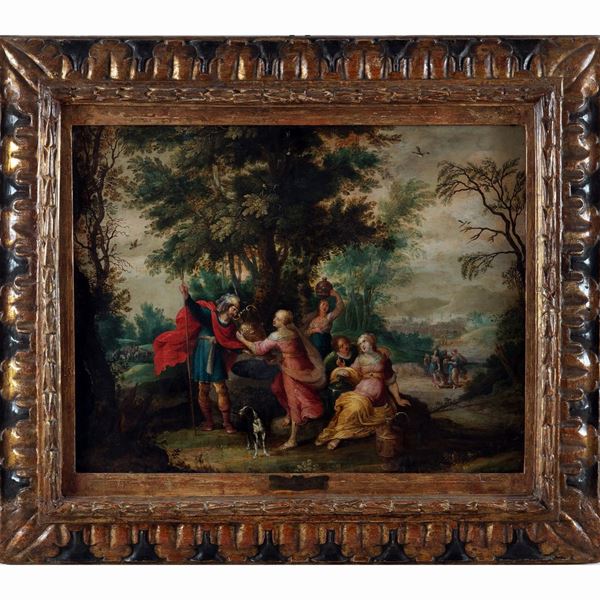Jan Brueghel II (Antwerp, 1601 - Antwerp, 1678)& Frans Francken II (Antwerp, 1581 - Antwerp, 1642)
Eliezer e Rebecca al pozzo
<... the landscape and the animals are by the Flemishpainter Jan Brueghel the younger (born in 1601 in Antwerp - died in 1678); the Old Testament figures of Eliezer, Rebecca and their entourage are instead thework of fellow painter Frans Francken the younger (born in 1581 in Antwerp -died in 1642).
The painting is a variant of the image with the same theme you can find today in the Prado in Madrid (Lit.1989, Cat 21 with fig.) which Franken created with Alexander Keirincx around the mid-1620s. Since Jan Brueghel the younger returned from Italy only in 1625 after his father’s death, the painting can only have been done in the late 20s. For Jan d.J, the first phase of his career is evidenced by the level of the details of the treesand landscape. In this period he is still the true witness of his father's legacy.
A Flemish phenomenon in 17th century painting is the collaboration of several painters on one painting. Artists specialized in different productions often teamed up and created surprisingly uniform compositions. Especially when dealing with figures of Christian subjects, Jand.J, in addition to Peter Paul Rubens and Hendrick van Balen, employs a member of the large Francken family who specialized in figures. Jan Brueghel has already worked with Frans Francken...>
Accompanied by Prof. Klaus Ertz’s expertise (13/06/2023)
K. Ertz, Jan Brueghel d.J., Die Gemälde mit kritischem Oeuvrekatalog, Freren 1984;
U. Härting, Frans Francken II, Die Gemälde mit kritischem Oeuvrekatalog, Freren 1989;
K. Ertz/C. Nitze-Ertz, Jan Brueghel d.Ä., Die Gemälde mit kritischem Oeuvrekatalog, Lingen 2008-10, Band I-IV





























